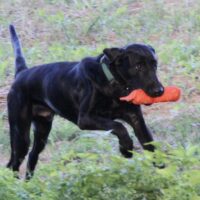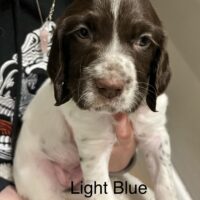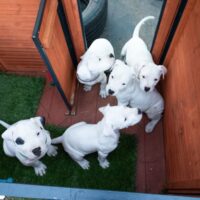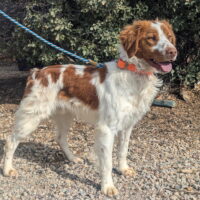Quartering is taught so that the dog will learn to run to objectives to his left and right. It is not a meaningless windshield wiper motion though it may appear as a long distance windshield wiper motion in featureless flat prairie grasslands. Bird dogs should seek objectives. In this instance, a quartering dog has no objective to run to rather he should cast wide left then cast wide right. A dog that runs a straight line in those areas will miss many birds. It is the act of the dog casting far to the left and right so as to ‘sweep’ the field and find birds. Some describe it as a windshield wiper motion however, that does not mean it is a back and forth action at 25 yards. If that is all you wanted, then all you would need is a close working flushing dog like a lab or cocker.
It behaves in a couple of different ways. If you are hunting in a location with ‘objectives’, that is, a place with edge cover, scattered mesquites, fence rows, irrigation ditches, etc. your dog should cast to the objectives on the right then cast to the objectives on the left. The dog has time to do this if foot handling. If pushing the dog from an ATV, horse , or Jeep, the dog will have less time to run to objectives left and right which may mean a second pass through that area. Not every hunting place has objectives like the mid-west, east coasters, and westerners are used to.
When teaching your dog to quarter, Give the one word command you want to use to turn pup. We use ‘hup’ or ‘yah’ though retriever trianers use ‘hup’ for sit. You can use whatever word you wish if this bothers you. Simultaneously with the corresponding whistle command, walk the desired direction yourself, arm outstretched with your hand signal pointing the direction you’re heading. Soon pup will learn that the word and whistle command means change directions. Once he understands both, you will want to give the verbal and whistle command separate so that he knows each mean the same. If you have to check him, and most do, simultaneously give the command to change direction and soon he will change immediately when you speak the verbal command because he does not want to be checked.
You should raise the arm on the side of your body that you intend pup to go. Reaching across your chest to indicate a direction can confuse the pup. Later, this translates to him looking when commanded afield so that he goes where you point with your outstretched arm. Eventually he’ll be so acclimated to your body language that you won’t even have to raise a hand to indicate direction, rather he will key off of the direction you are facing. If you hunt from a horse, jeep, ATV, etc, he will begin to key off the direction your mode of transportation is pointed.
Plant a couple pigeons in hidden remote DT systems launchers about 50 to 75 yards apart in natural objectives. On a long check cord, let him run to the end and lead him _away_ but near the first birds scent cone. Then give him the quartering command/whistle (hup) while walking towards the scent cone with outstretched arm pointing towards the birds scent cone. If he disobeys, simply take him into the scent cone. He will point/flush (depending on training), you fire the blank gun/kill the bird if he points it. If he’s not pointing yet, simply let him see the flushing bird and get excited. He will want to go after that bird but instead take him towards the opposite launcher and repeat the sequence. Repeat this sequence several times over several lessons and he will quarter with you as he now thinks you are the almighty BIRD god. He will WANT to quarter/come with you whenever you ask.
Later in his training, you can use the method to teach the dog that you have discovered birds on your own and can simply call in him by saying “birds in here” or whatever term/signal you wish to use. Yes, it’s the dogs job but there ARE times afield when your dog is one direction and you see and/or hear wild birds the other direction.











Speak Your Mind